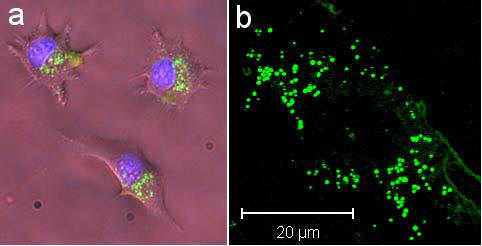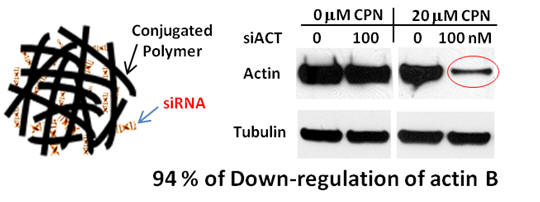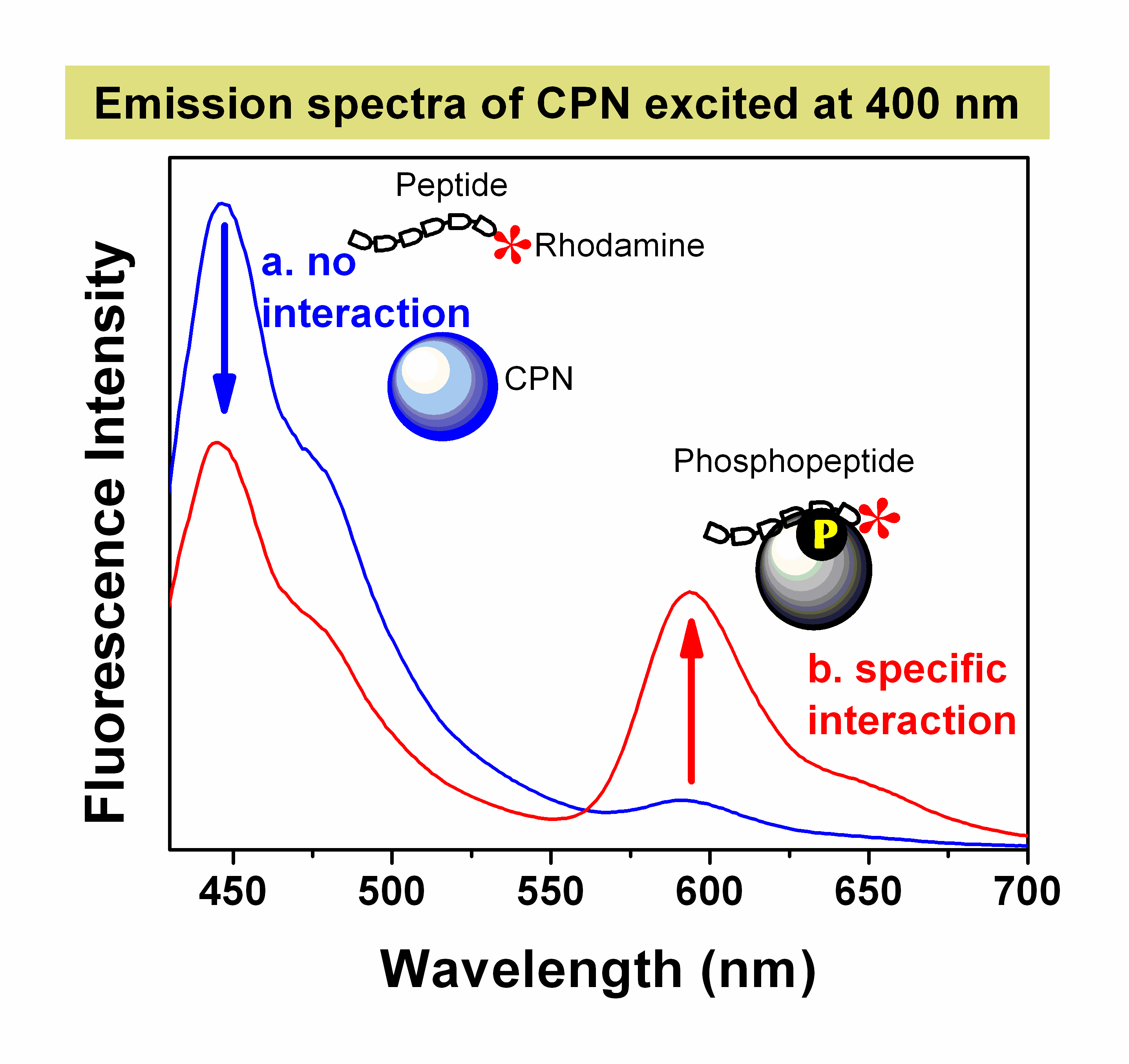 |
|
Live cell imaging application:
Fluorescent labeling and detection of target biological molecules in live cells is an essential way of studying complex and dynamic cellular processes.
An amine-containing poly(phenylene ethynylene) (PPE) was designed and fabricated into Conjugated polymer nanoparticles (CPNs), and the resulting CPNs were used for live cell imaging.
Confocal microscopic studies suggests that CPNs are taken up by various cells without inhibition of cell viability, and accumulated in some vesicular structures such as early or late endosomes. In addition, CPNs exhibit high resistance to photobleaching, in contrast to commercially available dyes.
We are interested in developing highly fluorescent CPNs through molecular design and aggregation controls. To provide target specificity, various bioconjugation techniques are applied to introduce targeting ligands to CPNs.
|
|
 |
|
Multiphoton Probes:
Fluorescent molecules can be excited by absorbing photons of certain energy (e.g. 400 nm), and the excited molecules release the absorbed energy as fluorescence emission. If the excitation light source carries extremely high photon density, the molecules can also be excited by simultaneous absorption of two-photons (2P) of lower energy (i.e. 800 nm). Because of the requirements for the 2P excitation, selective excitations of the fluorophores occur at the focal point that supports various applications including deep tissue microscopic imaging.
Our initial experiments indicate that CPNs exhibit extremely large 2P action cross sections, comparable photostability to QDs, and non-toxicity. The measured 2P action cross-section of the CPNs as a function of excitation wavelength is shown in Figure. These cross-sections are at least 2–3 orders of magnitude higher than conventional organic fluorophores.
Through a collaboration with Prof. Peter So at MIT, we are investigating CPNs as a promising 2P probes for in vivo tissue imaging.
|
|
 |
|
Small interfering RNA delivery:
RNA interference as a gene regulation tool necessitates specific delivery of optimal amounts of double-stranded RNA to target cells or tissues without toxic side effects. Due to their simplicity and synthetic versatility, various non-viral, positively-charged synthetic carriers have been developed and used for delivery of long DNA or short interfering RNA (siRNA). Positively charged CPs are promising fluorescent materials useful for siRNA delivery in vitro.
Loosely aggregated CPNs were used as nontoxic and efficient siRNA delivery vehicles with delivery visualization. A significant down regulation (94%) of a target gene was achieved by transfection of HeLa cells with the CPNs/siRNA complexes, supporting CPN as a promising siRNA delivery carrier.
|
|
 |
|
Biochemical Kinase Assay:
Many diseases such as cancers, diabetes, and inflammation are closely related to uncontrolled functions of certain protein kinases that phosphorylate substrates in the signalling pathways. Because of their pivotal roles on the cellular process and diseases consequences, these pathways are prime targets for drug discovery. Among the biochemical assays, fluorescence-based homogeneous assays are widely used because they can detect phosphorylation events with a high degree of sensitivity and because they avoid radioisotopic labels.
Here we exploit the efficient energy transfer of CPNs for the sensitive detection of rhodamine-labeled peptides commonly used as substrates for kinase enzymes. Highly efficient energy transfer from CPNs to rhodamine allows for the quantitative monitoring of phosphorylation of the peptide substrates by monitoring both fluorescence quenching (FQ) and FRET. We demonstrated a biochemical kinase assay for screening inhibitors in a multiwell format. Combined with the advantage of the large spectral difference between the excitation and emission wavelengths, ratiometric analysis from fluorescence quenching (FQ) of CPN and FRET to rhodamine allows for sensitive and reliable detection of the substrate phosphorylation.
|





